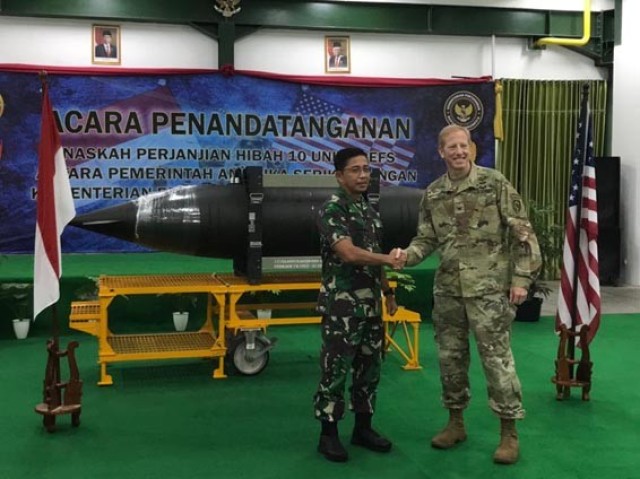Government officials marked the arrival of U.S. equipment that is expected to strengthen Indonesia’s military capabilities during a handover ceremony July 8 in the historic, port city of Semarang.
As part of a foreign military sales case executed by the U.S. Army Security Assistance Command, Indonesia was granted several Reduced Crashworthy External Fuel System (RCEFS) via the DoD-appropriated Building Partner Capacity (BPC) program. BPC builds partnerships with foreign nations by providing materiel and training to enhance partner and allied capabilities within each of the Combatant Commands.
The RCEFS are fuel tanks designed to extend the fuel capacity and range of Indonesia’s previously purchased AH-64D APACHE Block III LONGBOW Attack Helicopters.
Indonesia submitted an FMS request to purchase eight Apache Guardians in 2012. The aircraft, along with associated support equipment and training, totaled an estimated $1.42 billion.
A release by the U.S. Defense Security Cooperation Agency stated that the APACHE sale contributes “to the foreign policy and national security of the United States by helping to improve the security of a friendly country which has been, and continues to be, an important force for political stability and economic progress in Southeast Asia.”
Dave Dornblaser, the director of USASAC’s Washington Field Office said the most recent transfer of fuel tanks to Indonesia is a continuation of U.S. efforts to build relationships with one of America’s vital partners in the Indo-Pacific region.
Strengthening this partnership remains a U.S. foreign policy priority, given Indonesia’s status as the world’s third-largest democracy, its historic leadership role in the Association of Southeast Asian Nations (ASEAN), and its role as president of the G20, according to the U.S. Department of State. Indonesia is the world’s third largest democracy, largest Muslim-majority country, the seventh-largest economy by purchasing power, and a leader in ASEAN. Consisting of over 17,000 islands, it borders the South China Sea, which has the world’s busiest sea lanes — more than $5 trillion in cargo and as much as 50 percent of the world’s oil tankers pass through the South China Sea every year.
On Aug. 3, thousands of U.S., Indonesian and partner nation Soldiers kicked off the 16th annual Garuda Shield combat exercises on the Sumatra and Riau islands. The two-week event has grown from a U.S.-Indonesian exercise to this year’s Super Garuda Shield, one of the biggest joint, multinational exercises in the Indo-Pacific region. 2022 participants included Australia, Singapore, Japan, Canada, France, India, Malaysia, New Zealand, the Republic of Korea, Papua New Guinea, Timor Leste, and the United Kingdom.
“This Indonesian-led exercise has grown in scope and scale,” said Maj. Gen. Stephen G. Smith, Commanding General, 7th Infantry Division and exercise director for Super Garuda Shield 2022. “Every time we can build our joint readiness is a great opportunity for us and the region. The growth of this exercise shows its importance and how these nations view this as a consequential area within the Indo-Pacific region.”
For more information on USASAC and how it builds partnerships in support of U.S. foreign policy, visit www.army.mil/usasac.




Social Sharing